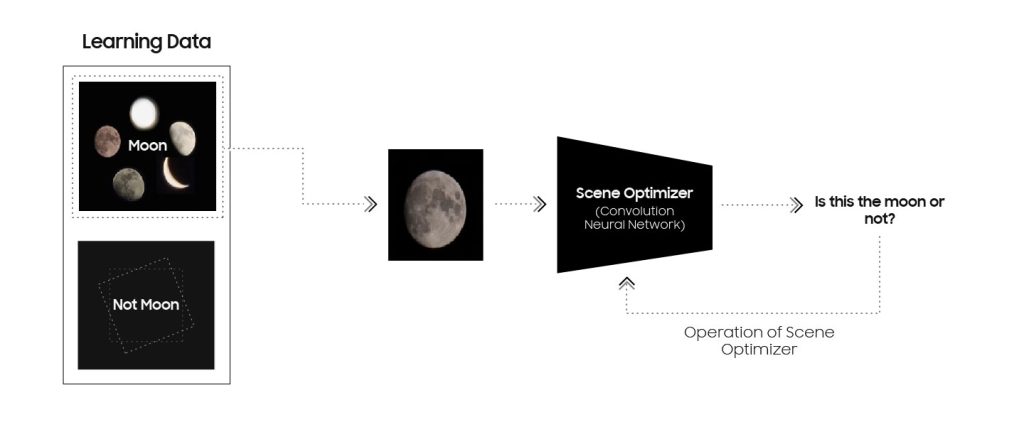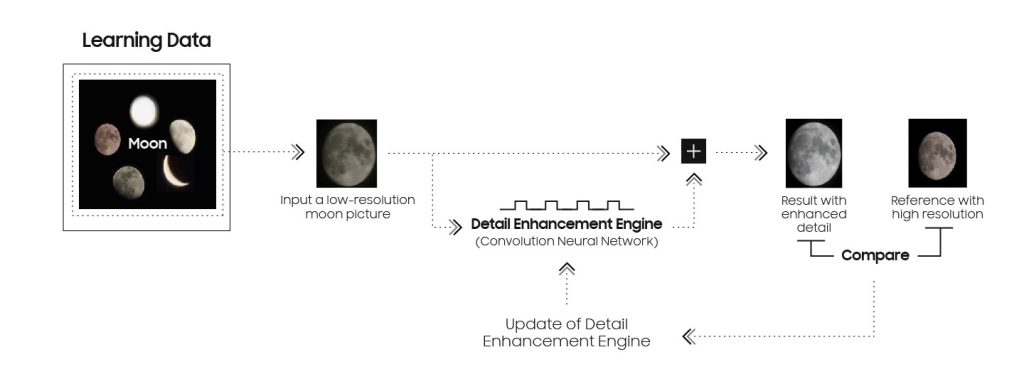
Samsung’s Galaxy Flagship smartphones have been offering 100x zoom and the ability to capture shots of the moon for a while now. However, a Reddit user claimed that the moon shots taken with Samsung’s space zoom feature were fake. They downloaded a high-resolution image of the moon, downsized it, and added a Gaussian blur to remove all details.
Samsung details how its moon photos work with Scene Optimizer feature
Samsung has now responded to these accusations by explaining how its moon photos work and why they aren’t completely fake. They use super resolution technologies and AI technology to produce high-quality moon images. The phone doesn’t apply any image overlaying to the photos; instead, the AI-based scene optimization technology recognizes the moon as the main object and takes multiple shots for multi-frame composition.

Samsung Scene Optimizer feature
Samsung’s Scene Optimizer feature uses advanced AI to recognize objects and provide the best results to users. With the Galaxy S21 series, the camera now recognizes the moon as a specific object during photo-taking and enhances details using its detail enhancement engine.
The camera system utilizes deep learning-based AI technology and multi-frame processing to further enhance details when taking photos of the moon. Learn more about the steps, processes, and technologies involved in capturing high-quality images of the moon.

AI Deep Learning for Moon Object Recognition
Samsung has developed an AI engine capable of recognizing the moon in various shapes and details, from full to crescent. It uses a deep learning model to detect the presence and location of the moon in images taken from Earth.
The AI model continues to learn and can recognize the moon even in images that were not used in training. With a simple square box denoting the area occupied by the moon, this technology is set to revolutionize the way we view and study the moon.
The Brightness Control Process and Capturing the Most Stable Images Possible
Samsung has developed a process to capture the most stable and clear images of the moon. The device recognizes the moon and controls the display brightness to optimize clarity. Even in early evening, the device will darken the background to enhance the moon’s visibility.

The Zoom Lock feature reduces shaking effects without a tripod using OIS and VDIS technologies. It activates automatically when zooming in on the moon or maintaining focus for more than 1.5 seconds. The border and display change to yellow, locking the moon in place for truly epic shots.

Samsung’s AI Powered Detail Enhancement to Capture the Moon
Samsung’s Galaxy device allows users to capture a bright and clear image of the moon. Once the moon reaches an appropriate brightness level, the user can press the capture button. The camera then utilizes Scene Optimizer to determine whether to apply the detail enhancement engine through AI processing.

Multiple pictures are taken and synthesized into a single, bright image with reduced noise through Multi-frame Processing.

Finally, the deep-learning-based AI detail enhancement engine of Scene Optimizer is used to eliminate remaining noise and enhance image details even further.
Scene Optimizer availability
Samsung’s Scene Optimizer is exclusively available on the Galaxy S20 and above models, as well as all Galaxy Z Fold series.
Explaining about AI Technology to Produce High-Quality Images of the Moon, Samsung, said
Samsung continues to improve Scene Optimizer to reduce any potential confusion that may occur between the act of taking a picture of the real moon and an image of the moon.
